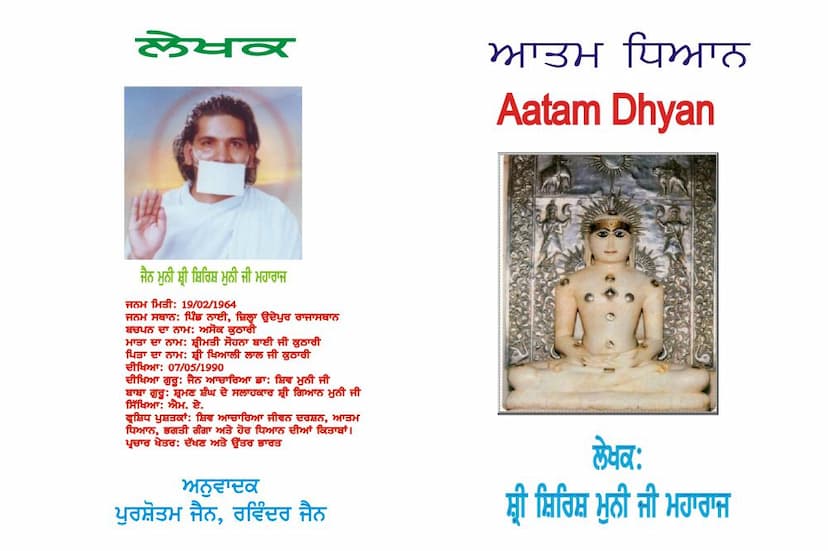Aatma Dhyan
Added to library: September 1, 2025
Loading image...

Summary
This document is a summary of the Jain text "Aatma Dhyan" (Self-Meditation) by Purushottam Jain and Ravindra Jain, based on the teachings of Jain Muni Shri Shirish Muni Ji Maharaj and Jain Acharya Dr. Shiv Muni Ji Maharaj. The book focuses on the practice and philosophy of "Aatma Dhyan" as a path to spiritual liberation and inner peace.
Key aspects covered in the text:
- Introduction to "Aatma Dhyan": The book defines "Aatma Dhyan" as a comprehensive meditation technique that goes beyond the physical and mental realms to achieve self-realization and liberation. It emphasizes that meditation is not just for moksha (liberation) but also a way to live a higher quality of life.
- The Nature of the Self ("Who Am I?"): The text poses the fundamental question of self-identity, "Who am I?". It suggests that true self-knowledge, understanding one's true nature, and returning to that nature is the ultimate goal of spiritual seekers. The path to this self-knowledge is internal, requiring introspection rather than external searching.
- The Importance of Meditation: Meditation is presented as the simplest and sweetest path to moksha, accessible to all ages and genders. It is highlighted as a science that helps one connect with their true self, which is described as infinite bliss, peace, and knowledge.
- The Process of "Aatma Dhyan": The meditation practice starts with purification of the body, followed by purification of speech, mind, consciousness, and ultimately the self. This journey leads to self-union or abiding in one's true nature, which is moksha.
- Levels of "Aatma Dhyan" Practice: The book outlines a structured progression of "Aatma Dhyan" courses:
- Aatma Dhyan Basic: A 5-day course focusing on living in the present, responsibility, leadership, self-knowledge, and the principles of pure dharma and self-nature. It includes asanas, pranayama, and meditation techniques.
- Aatma Samadhi Course: Teaches entering samadhi (deep meditative absorption) through mantras, positive thinking, and advanced meditation.
- Aatma Dhyan Advance - 1: A 3-day camp focusing on detachment, devotion, surrender, service, faith, pure self-knowledge, pure samayik, and entering Dharma Dhyan and Shukla Dhyan.
- Aatma Dhyan Advance - 2: A 4-day residential camp for serious practitioners, involving deep meditative practices, silence, introspection, and ethical conduct.
- Aatma Dhyan Advance - 3: A 7-day residential camp for advanced practitioners, focusing on the path towards oneness and duality.
- Aatma Dhyan Teacher Training Course: Equips individuals to teach "Aatma Dhyan" to others.
- The Core Message of "Aatma Dhyan":
- Bliss is our inherent nature: Happiness is not found externally but is an intrinsic quality of the soul. Seeking happiness outside is a misunderstanding that leads to suffering.
- Peace resides within: Inner peace is a direct experience of the soul.
- Knowledge is the Self: True knowledge is the understanding of one's true self. "Aatma Dhyan" helps in clearing the dust of ignorance covering this innate knowledge.
- The Importance of Living in the Present Moment: The text emphasizes the significance of living in the present, as the past is gone and the future is uncertain. Being present is key to wisdom and happiness.
- The Concept of Responsibility: Taking responsibility for one's actions, thoughts, and circumstances is presented as a crucial step in spiritual growth. It fosters inner strength and self-reliance, moving one from a follower mentality to a leader mentality.
- The Art of Being Happy: The book explores the difference between external pursuits of happiness and cultivating inner joy. It uses examples to illustrate how a positive, accepting attitude (leader's mindset) leads to happiness, while a resistant, negative attitude (follower's mindset) leads to stress and suffering.
- The Practice of Asanas and Pranayama: The text provides guidance on specific yogic postures (asanas) like Vajrasana, Skand Chalana, Pad Chalana, and various breathing exercises (pranayama) like Kapalbhati, Deep Breathing, and Ujjayi breath, explaining their physical and mental benefits.
- The Concept of "So'ham" (I am That): The practice of chanting "So'ham" is introduced as a way to realize the oneness of the self with the divine, transcending the physical body and external identifications.
- The Nature of True Religion (Dharma): Dharma is defined not by external rituals or sectarian beliefs but by one's inherent nature. The inherent nature of water is coolness, and the inherent nature of the soul is bliss, peace, and knowledge. Abiding in one's true nature is considered true religion.
- The Importance of Sattvic Food: The text advocates for a sattvic (pure, balanced) diet, highlighting the negative impacts of tamasic (impure, dulling) and rajasic (stimulating, agitating) foods on both the body and mind. It emphasizes vegetarianism from an ethical and physical perspective.
- Guidance for Spiritual Journey: The book encourages practitioners to be the "leaders" of their spiritual journey, embracing responsibility, living in the present, and cultivating a positive outlook to achieve lasting happiness and self-realization.
In essence, "Aatma Dhyan" is presented as a practical and transformative guide to understanding and experiencing the true self through meditation, breathing exercises, and ethical living, aligning with the principles of Jainism.